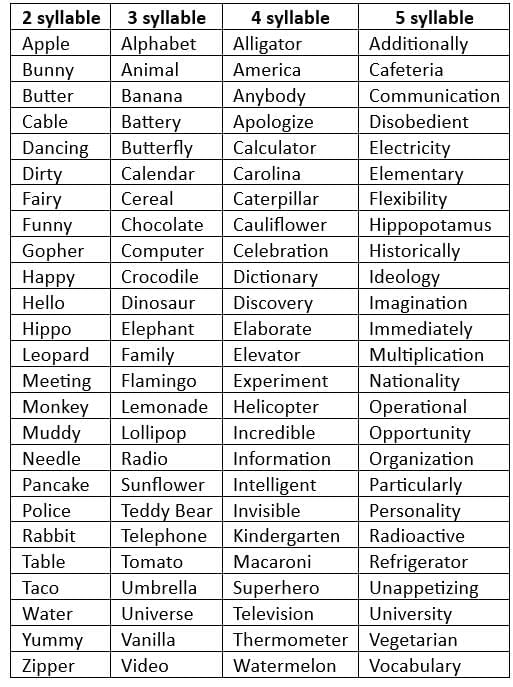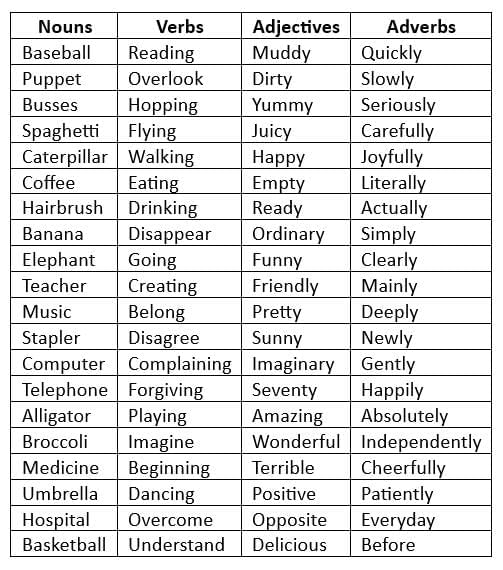Multisyllabic Words Chapter Notes | Language Arts for Grade 3 PDF Download
Introduction
Multisyllabic words are those with more than one syllable or vowel sound. These words play a significant role in speech therapy, primarily used to improve articulation skills, though they are also employed for word decoding and phonological awareness. This resource offers a detailed list of multisyllabic words, organized by syllable count and word type, to assist parents and speech therapists working with children on these skills.
What Are Multisyllabic Words?
Multisyllabic words are extended words with two or more syllables. In speech therapy, they are a common focus for various therapeutic goals. Speech therapists may target multisyllabic words to address issues such as:
- Omitting weaker syllables (e.g., saying “Nana” instead of “Banana”)
- Leaving out consonants (e.g., saying “Able” for “Table” or “Buh-er” for “Butter”)
- Articulation challenges
- Struggles with phonological processing or awareness
Mastering the pronunciation, combination, or decoding of multisyllabic words is essential for speech development, reading comprehension, vocabulary growth, and clear communication.
Why Do we Target Multisyllabic Words?
- Many children struggle to articulate all the sounds and syllables in words with multiple syllables. Some children exhibit a phonological process known as “weak syllable deletion,” where they leave out a less stressed syllable, such as saying “batty” instead of “battery” or “ah-gator” for “alligator.” Others may find it challenging to produce multisyllabic words due to difficulties with specific speech sounds.
- For instance, a child who substitutes /t/ for /k/ might struggle to say “crocodile” clearly. In many cases, children may face both of these challenges simultaneously.
List of Over 100 Multisyllabic Words
- Below is a detailed list of multisyllabic words, organized by category. When targeting multisyllabic words in speech therapy, it’s crucial to choose words that are familiar and relevant to the child.
- Using words that are meaningful or commonly used increases the likelihood that the child will incorporate them into everyday conversation. This list provides numerous word options but is not an exhaustive collection of all possible words for this purpose.

Multisyllabic Word Lists by Word Structure
- Multisyllabic words appear across all parts of speech. Depending on a child’s age or language proficiency, certain word types may be more suitable for targeting.
- For example, younger children, like preschoolers, tend to use fewer adjectives or adverbs, making it more effective to focus on multisyllabic nouns or verbs to ensure the words are relevant and meaningful. Below is a list of multisyllabic words categorized by their word form:

Pronouncing Multisyllabic Words
Multisyllabic words, due to their complexity, can pose greater difficulties for children with moderate to severe articulation or phonological disorders, or those with apraxia of speech. Fortunately, there are several effective strategies to support children in learning to pronounce these words accurately.
Touch Cues
- Touch cues are an effective method for helping children recognize all the syllables they hear (or should hear) in a word, while also allowing adults to provide feedback on the number of syllables a child produces.
- These cues can include actions like tapping on the hand, arm, or table. Combining touch cues with visual cues, such as using dots or circles to represent each syllable, can further support children in improving their pronunciation.
Mouth Cues
- Mouth cues can be more challenging than touch cues, and guidance from a speech-language pathologist is often helpful when incorporating them into home practice.
- Mouth cues can range from simple gestures, like pointing to the mouth, to more intricate hand signals representing specific sounds.
- Complex hand cues are particularly useful for children working on multisyllabic words, as they help clarify the distinct sounds being heard, making it easier for children to replicate them.
Word Segmentation
- Word segmentation is an excellent approach for practicing words with prefixes or suffixes. This technique involves starting with the base word, which the child can pronounce more easily, and then adding the prefix or suffix with a slight pause.
- For example, when working on the word “unhappy,” you might say “un…happy” to emphasize the additional syllable. This strategy can often be combined with other techniques for enhanced effectiveness.
Visual Aids
- Visual aids can come in various forms, such as writing the word out, using dots or images to represent syllables, or including visuals for specific speech sounds the child is practicing.
- While visual aids are most effective when paired with other strategies, they can be highly beneficial for children.
Knowing Where to Start
- When practicing multisyllabic words, it’s generally not advised to begin with the most complex words. Instead, start with two-syllable words, progress to three-syllable words, and continue advancing as the child masters each stage.
- Choosing the appropriate starting level is crucial to keep the child motivated. If the task is too difficult initially, they may lose interest in continuing their practice.
Games & Activities for Multisyllabic Words
When practicing multisyllabic words in speech therapy, whether as a parent or a speech-language pathologist, the following games and activities can be highly effective. Fun and engaging activities are essential for capturing children’s attention and promoting quicker progress in mastering multisyllabic words.
Coloring
- Coloring is a captivating activity suitable for children of all ages. To incorporate multisyllabic words into coloring, select 10-15 words appropriate for your child’s level and either draw or print images representing those words.
- As the child colors each picture, encourage them to practice saying the word, focusing on using all syllables and their best speech sounds.
Drumming Syllables
- Children enjoy drumming, whether on a table, wall, or an actual drum if available. This activity helps build awareness of the number of syllables in words and can be practiced in various ways.
- For example, you can say a word while drumming its syllables and have the child mimic you, say the word and let the child drum the syllables, show a picture and have them drum the syllables, or create songs incorporating the words they’ve been practicing.
Silly Sentences
- This activity is ideal for children who have been practicing multisyllabic words for some time but struggle to use longer words in conversation. Choose two words from your word list and take turns creating humorous sentences that include both words.
- For example, with the words “flamingo” and “alphabet,” you might say, “The flamingo danced to the alphabet.” You can also write these sentences down for additional practice later.
Discrimination Activities
- Discrimination activities are beneficial for children who are just beginning or advancing to words with more syllables. One approach is to gather a variety of objects and have the child sort them based on the number of syllables in their names.
- For example, using items like scissors, tissue, tablet, pencil, a stuffed kangaroo, a lollipop, and a telephone, the child can group them into 2-syllable and 3-syllable categories. This can also be done with pictures or by simply saying the words to the child without physical objects.
Reading
- Reading with your child is a valuable activity for any speech therapy goal. To focus on multisyllabic words during reading, first determine your child’s current level (2, 3, 4, or 5 syllables).
- As you read together, pause whenever you encounter a word at their level and practice saying it together. For older children or those working on carryover, encourage them to use the word in the full sentence for additional practice.
Using Forbrain for Enhanced Sound Practice
- Forbrain is a headset designed for auditory stimulation that employs bone conduction to transmit your voice to your brain more quickly. It enhances the vibrancy of your voice by amplifying high frequencies while reducing low frequencies.
- Forbrain is a valuable tool for practicing multisyllabic words in speech therapy, as it provides instant feedback on the produced word, including its speech sounds and syllable count.
- This real-time feedback supports children in developing self-monitoring skills, enabling them to adjust their pronunciation or responses independently. Using Forbrain can accelerate progress in mastering the production of all sounds and syllables in multisyllabic words.
Final Words
- Many children struggle with accurately pronouncing multisyllabic words, facing challenges with producing all syllables, articulating specific sounds, or both. Mastering the correct pronunciation of multisyllabic words is crucial for effective communication with others.
- If you are concerned about your child’s ability to pronounce words with multiple syllables, consider consulting a licensed speech-language pathologist to determine if speech therapy is appropriate.
- You can use this tool to find a speech-language pathologist in your area as a starting point. In the meantime, the resources, games, and activities outlined in this article may be useful for supporting your child’s practice at home.
|
49 videos|156 docs|53 tests
|
FAQs on Multisyllabic Words Chapter Notes - Language Arts for Grade 3
| 1. What are multisyllabic words? |  |
| 2. Why is it important to target multisyllabic words in education? |  |
| 3. Can you provide examples of multisyllabic words? |  |
| 4. How can games and activities help with learning multisyllabic words? |  |
| 5. How does using tools like Forbrain enhance the practice of multisyllabic words? |  |




















